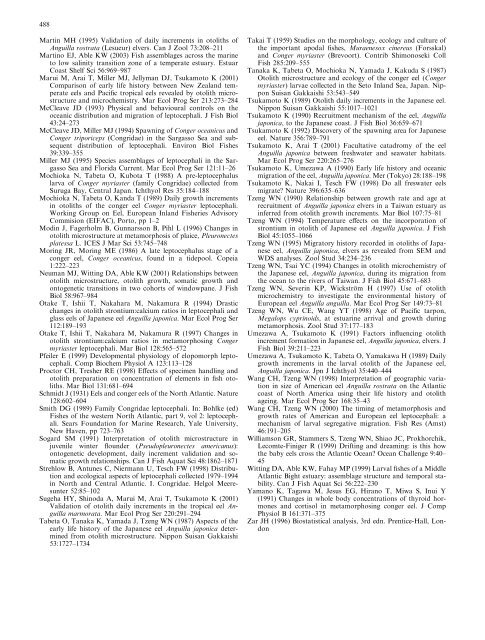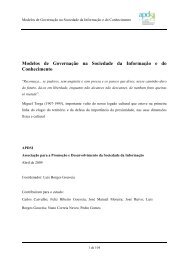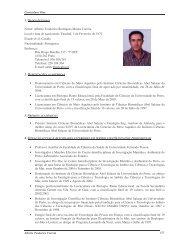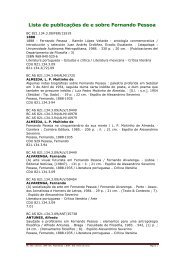Early life history of the American conger eel ... - ResearchGate
Early life history of the American conger eel ... - ResearchGate
Early life history of the American conger eel ... - ResearchGate
You also want an ePaper? Increase the reach of your titles
YUMPU automatically turns print PDFs into web optimized ePapers that Google loves.
488Martin MH (1995) Validation <strong>of</strong> daily increments in otoliths <strong>of</strong>Anguilla rostrata (Lesueur) elvers. Can J Zool 73:208–211Martino EJ, Able KW (2003) Fish assemblages across <strong>the</strong> marineto low salinity transition zone <strong>of</strong> a temperate estuary. EstuarCoast Shelf Sci 56:969–987Marui M, Arai T, Miller MJ, Jellyman DJ, Tsukamoto K (2001)Comparison <strong>of</strong> early <strong>life</strong> <strong>history</strong> between New Zealand temperate<strong>eel</strong>s and Pacific tropical <strong>eel</strong>s revealed by otolith microstructureand microchemistry. Mar Ecol Prog Ser 213:273–284McCleave JD (1993) Physical and behavioural controls on <strong>the</strong>oceanic distribution and migration <strong>of</strong> leptocephali. J Fish Biol43:24–273McCleave JD, Miller MJ (1994) Spawning <strong>of</strong> Conger oceanicus andConger triporiceps (Congridae) in <strong>the</strong> Sargasso Sea and subsequentdistribution <strong>of</strong> leptocephali. Environ Biol Fishes39:339–355Miller MJ (1995) Species assemblages <strong>of</strong> leptocephali in <strong>the</strong> SargassoSea and Florida Current. Mar Ecol Prog Ser 121:11–26Mochioka N, Tabeta O, Kubota T (1988) A pre-leptocephaluslarva <strong>of</strong> Conger myriaster (family Congridae) collected fromSuruga Bay, Central Japan. Ichthyol Res 35:184–188Mochioka N, Tabeta O, Kanda T (1989) Daily growth incrementsin otoliths <strong>of</strong> <strong>the</strong> <strong>conger</strong> <strong>eel</strong> Conger myriaster leptocephali.Working Group on Eel, European Inland Fisheries AdvisoryCommision (EIFAC), Porto, pp 1–2Modin J, Fagerholm B, Gunnarsson B, Pihl L (1996) Changes inotolith microstructure at metamorphosis <strong>of</strong> plaice, Pleuronectesplatessa L. ICES J Mar Sci 53:745–748Moring JR, Moring ME (1986) A late leptocephalus stage <strong>of</strong> a<strong>conger</strong> <strong>eel</strong>, Conger oceanicus, found in a tidepool. Copeia1:222–223Neuman MJ, Witting DA, Able KW (2001) Relationships betweenotolith microstructure, otolith growth, somatic growth andontogenetic transitions in two cohorts <strong>of</strong> windowpane. J FishBiol 58:967–984Otake T, Ishii T, Nakahara M, Nakamura R (1994) Drasticchanges in otolith strontium:calcium ratios in leptocephali andglass <strong>eel</strong>s <strong>of</strong> Japanese <strong>eel</strong> Anguilla japonica. Mar Ecol Prog Ser112:189–193Otake T, Ishii T, Nakahara M, Nakamura R (1997) Changes inotolith strontium:calcium ratios in metamorphosing Congermyriaster leptocephali. Mar Biol 128:565–572Pfeiler E (1999) Developmental physiology <strong>of</strong> elopomorph leptocephali.Comp Biochem Physiol A 123:113–128Proctor CH, Tresher RE (1998) Effects <strong>of</strong> specimen handling andotolith preparation on concentration <strong>of</strong> elements in fish otoliths.Mar Biol 131:681–694Schmidt J (1931) Eels and <strong>conger</strong> <strong>eel</strong>s <strong>of</strong> <strong>the</strong> North Atlantic. Nature128:602–604Smith DG (1989) Family Congridae leptocephali. In: Bohlke (ed)Fishes <strong>of</strong> <strong>the</strong> western North Atlantic, part 9, vol 2: leptocephali.Sears Foundation for Marine Research, Yale University,New Haven, pp 723–763Sogard SM (1991) Interpretation <strong>of</strong> otolith microstructure injuvenile winter flounder (Pseudopleuronectes americanus):ontogenetic development, daily increment validation and somaticgrowth relationships. Can J Fish Aquat Sci 48:1862–1871Strehlow B, Antunes C, Niermann U, Tesch FW (1998) Distributionand ecological aspects <strong>of</strong> leptocephali collected 1979–1994in North and Central Atlantic. I. Congridae. Helgol Meeresunter52:85–102Sugeha HY, Shinoda A, Marui M, Arai T, Tsukamoto K (2001)Validation <strong>of</strong> otolith daily increments in <strong>the</strong> tropical <strong>eel</strong> Anguillamarmorata. Mar Ecol Prog Ser 220:291–294Tabeta O, Tanaka K, Yamada J, Tzeng WN (1987) Aspects <strong>of</strong> <strong>the</strong>early <strong>life</strong> <strong>history</strong> <strong>of</strong> <strong>the</strong> Japanese <strong>eel</strong> Anguilla japonica determinedfrom otolith microstructure. Nippon Suisan Gakkaishi53:1727–1734Takai T (1959) Studies on <strong>the</strong> morphology, ecology and culture <strong>of</strong><strong>the</strong> important apodal fishes, Muraenesox cinereus (Forsskal)and Conger myriaster (Brevoort). Contrib Shimonoseki CollFish 285:209–555Tanaka K, Tabeta O, Mochioka N, Yamada J, Kakuda S (1987)Otolith microstructure and ecology <strong>of</strong> <strong>the</strong> <strong>conger</strong> <strong>eel</strong> (Congermyriaster) larvae collected in <strong>the</strong> Seto Inland Sea, Japan. NipponSuisan Gakkaishi 53:543–549Tsukamoto K (1989) Otolith daily increments in <strong>the</strong> Japanese <strong>eel</strong>.Nippon Suisan Gakkaishi 55:1017–1021Tsukamoto K (1990) Recruitment mechanism <strong>of</strong> <strong>the</strong> <strong>eel</strong>, Anguillajaponica, to <strong>the</strong> Japanese coast. J Fish Biol 36:659–671Tsukamoto K (1992) Discovery <strong>of</strong> <strong>the</strong> spawning area for Japanese<strong>eel</strong>. Nature 356:789–791Tsukamoto K, Arai T (2001) Facultative catadromy <strong>of</strong> <strong>the</strong> <strong>eel</strong>Anguilla japonica between freshwater and seawater habitats.Mar Ecol Prog Ser 220:265–276Tsukamoto K, Umezawa A (1990) <strong>Early</strong> <strong>life</strong> <strong>history</strong> and oceanicmigration <strong>of</strong> <strong>the</strong> <strong>eel</strong>, Anguilla japonica. Mer (Tokyo) 28:188–198Tsukamoto K, Nakai I, Tesch FW (1998) Do all freswater <strong>eel</strong>smigrate? Nature 396:635–636Tzeng WN (1990) Relationship between growth rate and age atrecruitment <strong>of</strong> Anguilla japonica elvers in a Taiwan estuary asinferred from otolith growth increments. Mar Biol 107:75–81Tzeng WN (1994) Temperature effects on <strong>the</strong> incorporation <strong>of</strong>strontium in otolith <strong>of</strong> Japanese <strong>eel</strong> Anguilla japonica. J FishBiol 45:1055–1066Tzeng WN (1995) Migratory <strong>history</strong> recorded in otoliths <strong>of</strong> Japanese<strong>eel</strong>, Anguilla japonica, elvers as revealed from SEM andWDS analyses. Zool Stud 34:234–236Tzeng WN, Tsai YC (1994) Changes in otolith microchemistry <strong>of</strong><strong>the</strong> Japanese <strong>eel</strong>, Anguilla japonica, during its migration from<strong>the</strong> ocean to <strong>the</strong> rivers <strong>of</strong> Taiwan. J Fish Biol 45:671–683Tzeng WN, Severin KP, Wickstro¨ m H (1997) Use <strong>of</strong> otolithmicrochemistry to investigate <strong>the</strong> environmental <strong>history</strong> <strong>of</strong>European <strong>eel</strong> Anguilla anguilla. Mar Ecol Prog Ser 149:73–81Tzeng WN, Wu CE, Wang YT (1998) Age <strong>of</strong> Pacific tarpon,Megalops cyprinoids, at estuarine arrival and growth duringmetamorphosis. Zool Stud 37:177–183Umezawa A, Tsukamoto K (1991) Factors influencing otolithincrement formation in Japanese <strong>eel</strong>, Anguilla japonica, elvers. JFish Biol 39:211–223Umezawa A, Tsukamoto K, Tabeta O, Yamakawa H (1989) Dailygrowth increments in <strong>the</strong> larval otolith <strong>of</strong> <strong>the</strong> Japanese <strong>eel</strong>,Anguilla japonica. Jpn J Ichthyol 35:440–444Wang CH, Tzeng WN (1998) Interpretation <strong>of</strong> geographic variationin size <strong>of</strong> <strong>American</strong> <strong>eel</strong> Anguilla rostrata on <strong>the</strong> Atlanticcoast <strong>of</strong> North America using <strong>the</strong>ir <strong>life</strong> <strong>history</strong> and otolithageing. Mar Ecol Prog Ser 168:35–43Wang CH, Tzeng WN (2000) The timing <strong>of</strong> metamorphosis andgrowth rates <strong>of</strong> <strong>American</strong> and European <strong>eel</strong> leptocephali: amechanism <strong>of</strong> larval segregative migration. Fish Res (Amst)46:191–205Williamson GR, Stammers S, Tzeng WN, Shiao JC, Prokhorchik,Lecomte-Finiger R (1999) Drifting and dreaming: is this how<strong>the</strong> baby <strong>eel</strong>s cross <strong>the</strong> Atlantic Ocean? Ocean Challenge 9:40–45Witting DA, Able KW, Fahay MP (1999) Larval fishes <strong>of</strong> a MiddleAtlantic Bight estuary: assemblage structure and temporal stability.Can J Fish Aquat Sci 56:222–230Yamano K, Tagawa M, Jesus EG, Hirano T, Miwa S, Inui Y(1991) Changes in whole body concentrations <strong>of</strong> thyroid hormonesand cortisol in metamorphosing <strong>conger</strong> <strong>eel</strong>. J CompPhysiol B 161:371–375Zar JH (1996) Biostatistical analysis, 3rd edn. Prentice-Hall, London
















